Samsung S95C OLED Review
Delivers a bigger improvement on its predecessor than we could have hoped for
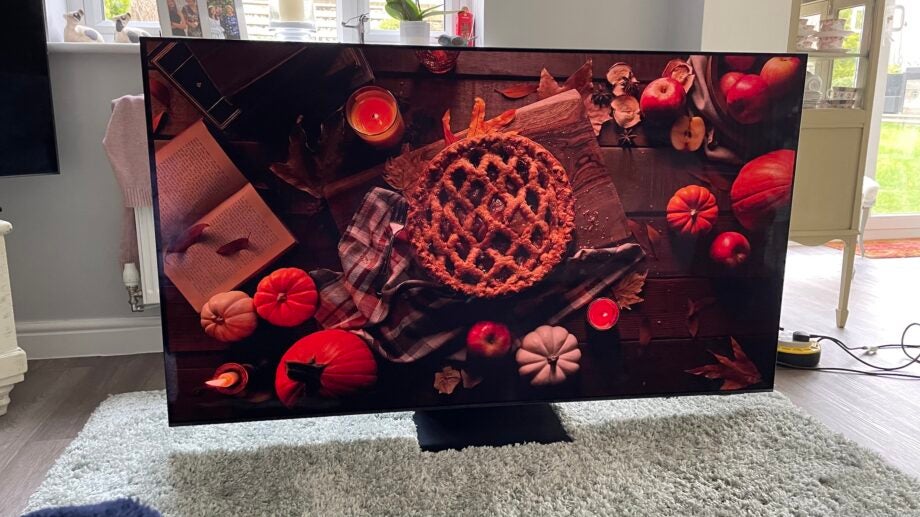

Verdict
We expected the QE65S95C to be even brighter and even more colourful than its QD OLED predecessor. We couldn’t have predicted the scale of these improvements, though – or how well they’d be controlled by Samsung’s latest AI processor
Pros
- Stunning, ground-breaking picture quality
- Gorgeous Infinity One design
- Outstanding gaming support
Cons
- No Dolby Vision
- Expensive even by OLED standards
- Smart interface can be unhelpful
Key Features
- QD-OLEDQD OLED technology for a brighter, more colourful image
- Tizen OSSamsung’s smart interface is home grown around its Tizen platform.
- GamingAMD FreeSync Premium Pro support
- One Connect boxAn external box contains connections, processor and powers the TV
- AudioSpeakers ranged around the screen’s bodywork place sound effects in the correct place
Introduction
When Samsung re-entered the OLED TV fray in 2022, after years of pushing LCD LED technology instead, it wasn’t just a case of the brand finally having to accept that sometimes if you can’t beat ‘em, you just have to join ‘em.
In fact, Samsung’s OLED return was prompted by a new approach to OLED technology involving Quantum Dot layers that enabled it to deliver colours using a pure red, green and blue system, minus the extra white element found in ‘traditional’ OLED TVs.
This new technology delivered fantastic TVs at the first time of asking in the shape of Samsung’s S95B range, making us wonder just where the technology might go from there. Happily, thanks to the new Samsung S95C we now know exactly where QD OLED is headed – and it’s glorious.
Availability
- UKRRP: £3599
- USARRP: $3299.99
- EuropeRRP: €4099
- CanadaTBC
- AustraliaTBC
The Samsung QE65S95C is available now in multiple territories across the world. In our main focus markets, the UK and US (where it is known as the QN65S95C), it costs £3,599 and $3,299.99 respectively. The Samsung S95C range doesn’t appear to be available in Australia at the time of writing.
There’s no getting round the fact that this is a lot of money for a 65-inch TV. Slightly more than LG’s G3 OLED TV with its brightness boosting Micro Lens Array technology. I’d argue, though, that actually the QE65S95C isn’t priced badly at all for something that’s using a still relatively new technology capable of changing the TV landscape.
Samsung is selling the QE65S95C for slightly less than its top-end 65-inch 4K Mini LED TV, the QE65QN95C. This suggests Samsung continues to see Mini LED as the cream of its TV technology crop – though there are many other much cheaper Mini LED TV series in Samsung’s range.
There’s also a cheaper range of QD OLED TVs this year: the S90C series. It’s still a little vague the ways it differs from the S95C, but it will be substantially less bright and feature less potent audio systems.
The QE65S95C is joined by 55- and 77-inch options – the latter being a very welcome big-screen addition to the QD OLED TV landscape.
Design
- Ultra-slim Infinity One styling
- External connections box
- Solar-powered remote
The Samsung S95C looks every inch the premium TV it is. Not that there are actually that many inches of it once you look beyond the epic 65-inch screen.
Its so-called (by Samsung’s marketing department!) Infinity One design sees it sporting the absolute bare minimum of frame around the screen, and an ultra-slim rear panel that’s as flat as the TV’s front.
Add a chic metallic finish for the slender slim side panels and you end up with an ultra-minimalistic, strikingly futuristic look that feels like the perfect fit for the TV world’s latest technology. Especially if you’re intending to hang the set up using its optional flush wall mount.
The build quality feels more solid than that of last year’s S95B QD OLED models, while the clean, minimal lines are able to avoid being messed up by the usual reams of cable spaghetti by the fact the Samsung QE65S95C ships with the external One Connect box.
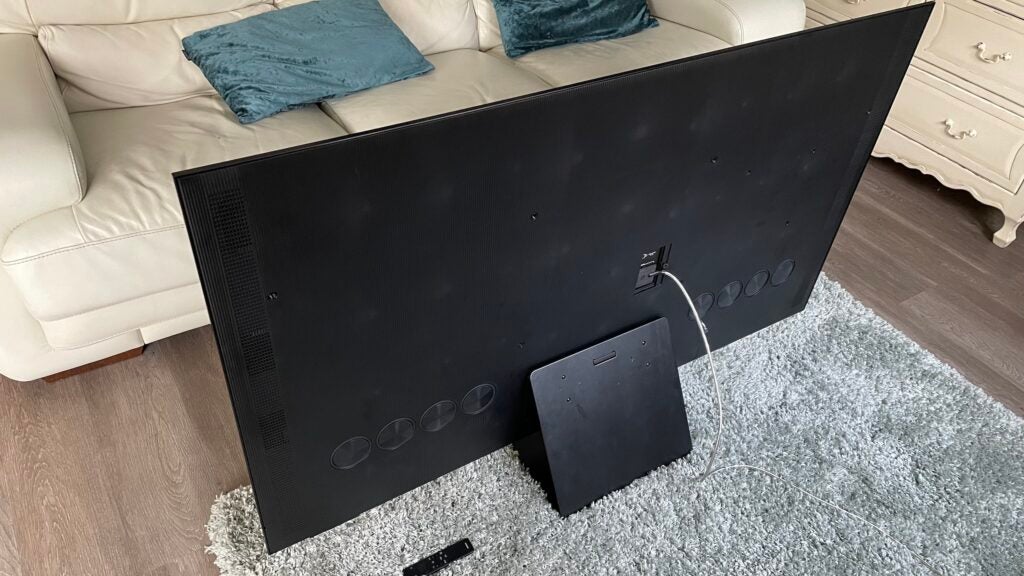
This houses all the TV’s connections and processing, and passes both images and power on to the screen using a single cable. This is particularly helpful to anyone thinking of hanging their new TV on a wall.
Even if you’re going to do as most people do and only attach the screen to its included desktop stand, the neck of that stand has been designed so that you can lean the One Connect box against its back, again making all the cables running into it easier to hide.
The desktop stand is a faff to build, but its rich metallic finish and hefty weight make it feel as premium as the rest of the TV’s design.
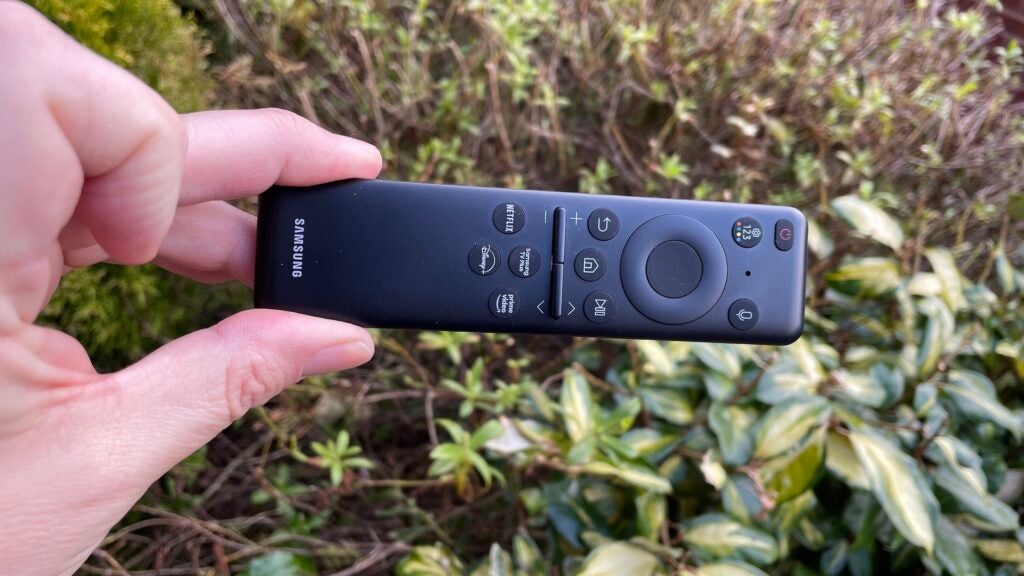
The Samsung QE65S95C ships with arguably the TV world’s most innovative remote control. As well as being unusually slim with a stripped down button count for streamlined day-to-day use, this ‘smart’ handset also features a solar panel on its back to save you from having to keep feeding it batteries.
In fact, it can even take power from your broadband router’s Wi-Fi signals, so even if you keep leaving the remote with the solar panel facing downwards it’s unlikely to ever run out of juice.
Features
- 2nd-gen QD OLED panel
- Comprehensive gaming support
- OTS and Dolby Atmos sound
Samsung Display, the makers of all Quantum Dot OLED panels, have delivered some significant hardware improvements for the second generation of QD OLED TVs. In particular, changes to the organic phosphor set up and the introduction of Deuterium to the panel design have enabled the screen to apparently achieve substantially more brightness without either using significantly more power or increasing the TV’s susceptibility to permanent image retention. I’ll be checking these claims out in the Picture Quality section, of course.
There’s also a new filter on the screen to reduce the issue noticed with the S95B where high levels of ambient light could reduce the TV’s otherwise outstanding black level performance.
Samsung Electronics, for its part, has taken the performance enhancements of Samsung Display’s new QD OLED panel, and bolstered them with a strong feature list that includes, crucially, much improved picture processing.
For instance, the Neural Quantum 4K processor’s brainpower has been compiled from the combined learning of a huge roster of 20 neural networks, arguably making the resulting system the most ‘AI’ heavy approach to picture quality I’ve seen to date.
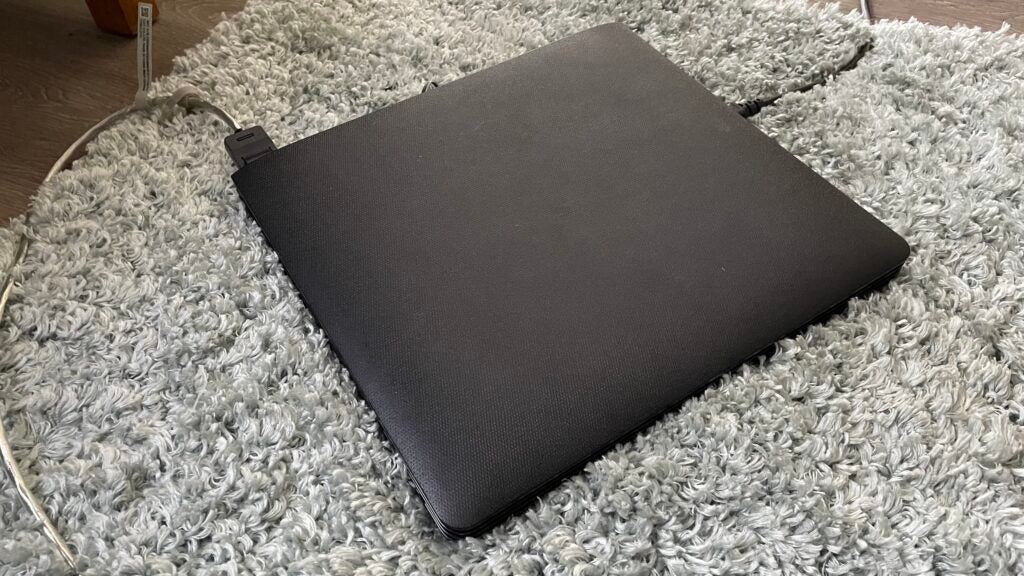
Among the many areas of picture performance the Neural Quantum 4K is designed to improve is Perceptual Colour Mapping, where the TV attempts to display colours in a way that more resembles how our eyes take in the real world. This desire to make images more lifelike also extends to a new object detection system that helps the picture look more three-dimensional and apply subtle emphasis to an image’s dominant elements.
The new processor boasts improved noise recognition and suppression, too (something that should prove especially helpful when it comes to remapping sub-4K content to the native 3840 x 2160 pixel count), as well as a brightness boosting system that focuses on getting the maximum expression out of an image’s lightest and darkest areas, right down to individual pixel levels of precision.
As usual Samsung provides customisable motion and noise processing controls, as well as a series of themed picture presets that includes the third party approved, accuracy-focused Filmmaker mode.
The OneConnect box carries four HDMI ports, all capable of handling the full 48Gbps of data associated with the HDMI 2.1 standard. This means the TV can take in almost everything the latest gaming world can throw at it, from 4K 120Hz (actually 144Hz refresh rates are supported) to automatic low latency mode switching signals and variable refresh rates that even extend to AMD’s FreeSync Premium Pro standard.
There’s support for the industry’s HGiG system too, where a console figures out the best HDR output for your particular TV, along with a host of game enhancements. These range from multiple genre-based picture and sound presets and the option to introduce picture quality enhancements at the expense of slightly slower response times, to handy ‘cheats’ in the shape of a mini map magnifier, a virtual aim target, and the option to make just the dark areas in the picture lighter, so that campers like me hiding in the darkest corners are easier to see.
The fastest response time in Game mode is a seriously rapid 9.2ms. All of the QE65S95C’s gaming features can be accessed easily in a Game Bar menu accessed by holding down the play button on the TV’s smart remote.
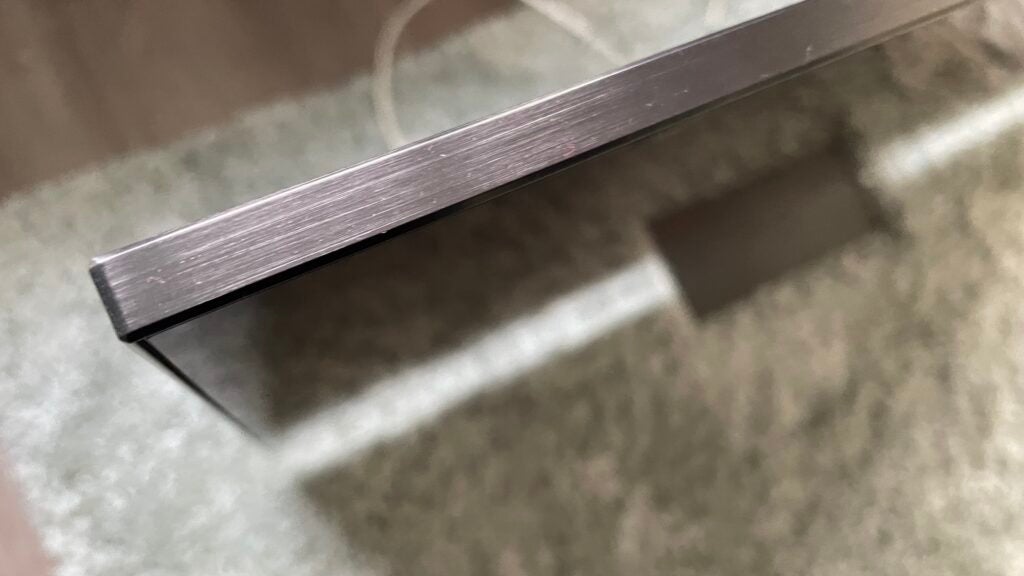
The only two cutting edge gaming features not supported by the Samsung S95C are 8K and Dolby Vision. The former because this is only a 4K TV; the latter because Samsung refuses to bite the Dolby Vision HDR licensing bullet. This also means the TV won’t play Dolby Vision off streams or 4K Blu-ray discs, resorting to playing DV-mastered content in basic HDR10 instead (in other words, without the extra scene-by-scene picture information DV masters carry).
The set does support the HDR10 and HLG HDR formats, plus Samsung’s own HDR10+ format. This joins Dolby Vision in adding scene by scene information to the data stream, but isn’t as widely available in the content world.
The Samsung QE65S95C’s smart features are delivered in a tweaked version of the new-look, full-screen Tizen-based menu system the brand introduced last year. The tweaks are certainly welcome – especially the more focused and useful content recommendation shelves that now make the home screen, and the more logical and refined rows of other shelves you can scroll down to from the home screen. The system runs less sluggishly, too.
The system still feels cumbersome compared to older, more compact Tizen approaches, and it isn’t always obvious or easy to trek through the menus to get to a desired feature or app. Fortunately, an excellent voice recognition system means you can often skip directly to a feature or service you want without needing to delve into the menus.
The Samsung S95C backs up its cutting edge picture tech with a promising audio system. As I’ve come to expect with Samsung’s premium TVs, the brand’s object tracking sound (OTS) system joins forces with Dolby Atmos decoding, pumped out by a genuine multi-channel (4.2.2) speaker arrangement that combines effects drivers ranged around the TV’s edges with eight large mid-range drivers somehow squeezed into the TV’s skinny rear.
Picture Quality
- Incredible brightness for OLED technology
- Stunning black levels and contrast
- Pretty much infinite viewing angles
It takes all of 30 seconds checking out what the Samsung S95C is capable of to obliterate any lingering concerns I might have had about whether this second-generation QD OLED screen could bring things on much in just 12 months. It’s superior to the S95Bs in a whole range of ways – substantially so in some areas.
The most surprising but important improvement is how much more refined its pictures look. While nobody could accuse the S95B of not delivering a jaw-droppingly aggressive demonstration of QD OLED’s capabilities, it could sometimes look a bit over-wrought, noisy or ‘showy’.
The Samsung QE65S95C’s processor marshals the various stunning capabilities of the latest QD OLED panel much more thoughtfully and carefully, serving up a more consistently balanced; believable, clean and refined image with almost any source thrown at it.
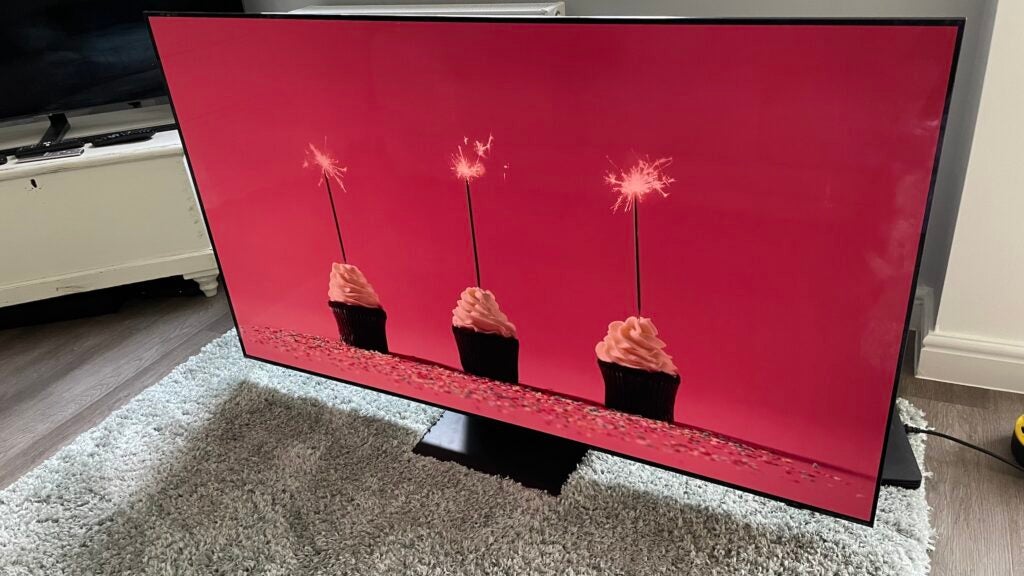
While the new processor’s more sensitive capabilities are perhaps at their most obvious when the TV is upscaling HD, where its ability to distinguish between source noise and genuine picture information leads to to some sensational results; they also have a palpable impact on native 4K content. Especially when adding an extra sense of depth and three-dimensionality, and ensuring (if you avoid the Dynamic picture preset) that nothing in the image is pushed to such an extreme that it looks forced or unnatural.
The well-calibrated Movie and Filmmaker Mode presets are there to give AV purists a short-cut to more accurate images than the relatively strident Standard preset.
While the various processing and panel control elements that deliver the sort of improvements I’ve been describing may only be quite small things individually, added together they make a huge difference to the S95C’s immersive qualities.
Especially as they are being applied to a level of brightness increase that feels much more revolutionary than evolutionary. The second-gen QD OLED panel delivers both small bright highlights and, even more eye-catchingly, full-screen bright HDR content with much more brightness than its predecessor could. And, therefore, than any previous OLED-based screen I’ve tested.
Tests show the Samsung S95C can punch out around 1400 nits of light on a 10% white HDR window, versus just under 1050 nits delivered by the S95B. That’s a leap of more than 30%. Full screen brightness manages 265 nits too, which is a good 25% and more higher than even the punchiest OLED technology.
Brightness is not the only important thing about a picture, even when you’re talking about HDR content. But it’s a pretty fundamental requirement for TVs that want to get the most impact and accuracy from aggressively mastered HDR sources.
Plus, high brightness can feed into a spectacular contrast performance when it’s been achieved without reducing the beautifully rich, deep black levels that’s made OLED TVs the choice of many discerning movie fans. You haven’t seen a good HDR movie star field until you’ve seen it on the Samsung S95C.
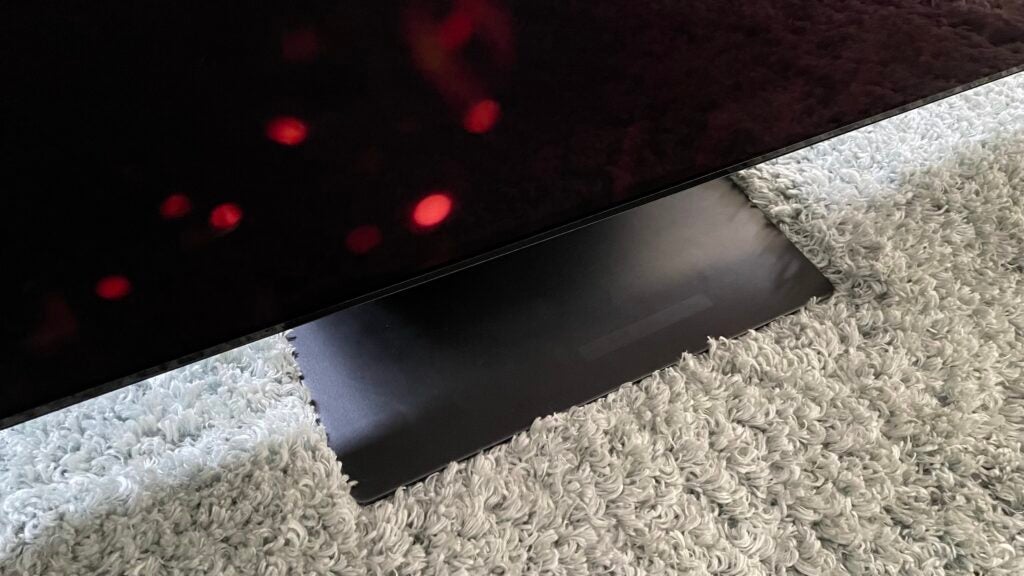
I should add here that regular OLED TVs – the ones that use white subpixels – sporting brightness boosting Micro Lens Array technology are arriving in 2023. At the time of writing, the Samsung 65S95C is in a class of its own when it comes to the sacred combination of brightness and contrast.
What’s more, these brightness and contrast strengths, together with Samsung’s more refined processing and QD OLED’s pure RGB configuration are able to produce fantastically vibrant, but also gorgeously subtle colours. The sort of colour volumes (hue/saturation plus brightness) the Samsung S95C can achieve are ground-breaking for the OLED world, unlocking natural shades in the brightest parts of the picture that other OLED technologies so far have not been able to reach.
Oddly, saturations slip a little in the Standard preset, perhaps because of that preset’s more dynamic focus on contrast and brightness achieved through a slightly over-enthusiastic default setting for the TV’s HDR Dynamic Tone Mapping feature. Overall though, the combination of boldness and subtlety in the 65S95C’s pictures is arguably its single most spectacular feature.
The Samsung QE65S95C’s pictures lose no saturation or contrast when viewed even from extreme angles either, and thanks to the set’s improved processing, the sense of sharpness and detail that’s been a strength of Samsung TVs is shifted up another gear.
It almost goes without saying that the 65S95C’s picture talents play out spectacularly well with the latest video games, giving you a new-found appreciation for what your console or PC is capable of. Despite the missing Dolby Vision support, I can think of no time the Samsung S95C looked less than fantastic with my Xbox Series X and PS5 consoles.
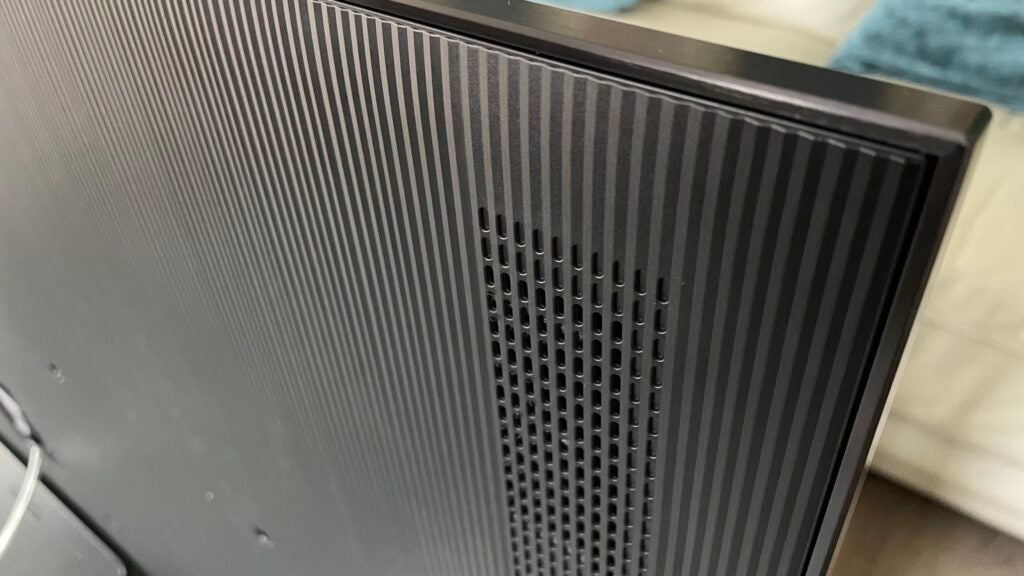
There are a trio of small niggles to report. First, the Standard preset, as well as at times slightly desaturating colours, can occasionally exhibit a distracting sudden brightness shift in the middle of a shot as it struggles to respond to a subtle shift in overall brightness. This doesn’t happen with the other presets so far as I can tell, though, and in any case it only crops up very rarely.
The set can only hold on to its peak brightness levels for a fairly limited time before having to dim down – but this won’t actually be an issue for the vast majority or regular video (rather than test signals) imagery. The screen can be forced to dim down, too, if it gets too hot – but the levels of heat involved shouldn’t be experienced in any regular viewing conditions.
Finally, for all the TV’s outstanding processing efforts in most areas, the 65S95C’s default motion settings are a bit of a mess. They generate too many unwanted digital side effects, as well as leaving film sources looking too devoid of the 24 frames a second judder that makes films feel like themselves. Judder can also feel a little too imposing with the motion processing turned fully off, though, so I’d recommend choosing a Custom option for the TV’s Picture Clarity settings and playing around with the blur and judder settings until you find the balance that suits best.
Sound Quality
- Built-in Dolby Atmos playback
- So-called OTS+ effects positioning system
- 70W of total power
Samsung’s obsession with ultra-skinny TV designs has seemingly caused its audio division a few headaches, with most (though not quite all) of its recent TVs struggling to produce the sort of sound quality their usually outstanding pictures deserve. This was especially true with last year’s S95B – so has the Samsung S95C suffered the same fate?
Actually, no, it hasn’t. While the speaker array doesn’t appear all that difference on the surface, its sensitivity and power handling is greatly improved. The eight mid-range drivers handle a reasonably broad dynamic range without typically sounding congested, stretched or flat out distorted as they did on the S95B, while the smaller speakers used to position specific effects in the correct place work much better.
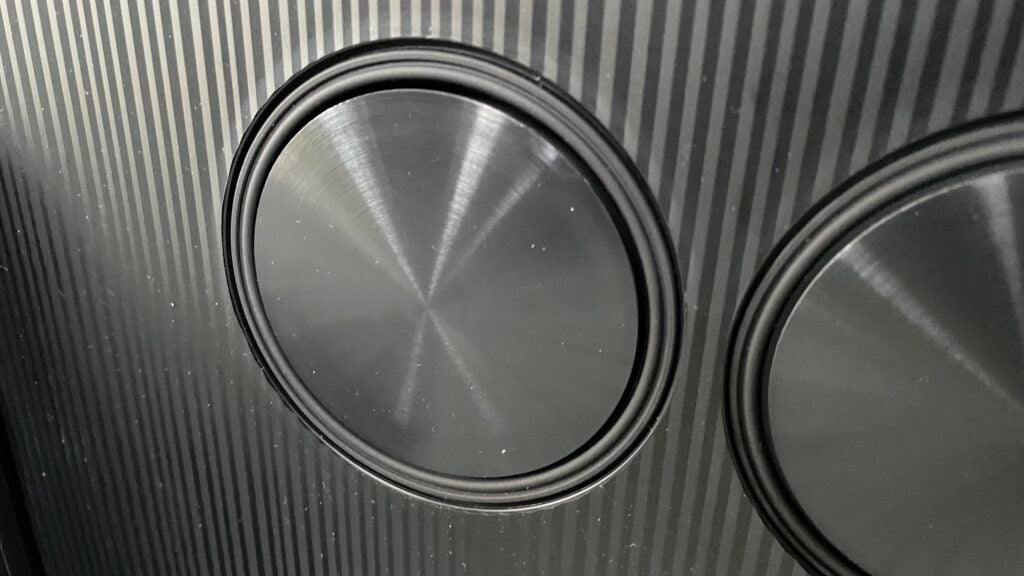
The soundstage sounds bigger as a result, pushing nicely past the TV’s outer edges to create a soundscape beyond the onscreen imagery – just as you would hope to hear with Dolby Atmos sound mixes in particular. The larger sound stage isn’t just ‘thrown out’ there either; effects are placed accurately within it, and the Samsung S95C typically keeps a good handle on the relative weighting of different sound mix elements. Including, most notably, dialogue, which as well as always sounding clear also emerges from the onscreen position of a speaker’s mouth with almost freakish precision.
While bass doesn’t reach as low with or emerge with as much force as I’d ideally like, it’s more present than it was with the S95B, and typically avoids its predecessor’s tendency to succumb to distracting phuts and buzzes.
The QE65S95C’s sound lacks some forward impetus too, leaving you feeling a bit disassociated from it at times. Overall, though, the S95C’s audio has gone from the sub-par level of its predecessor into territory that your ears actually quite enjoy hanging out with.
Latest deals
Should you buy it?
Second-gen QD OLED delivers the brightness goods: While brightness isn’t everything, it certainly helps – especially with HDR. The Samsung S95C not only finds more than 30% more brightness than its predecessor, but also applies that brightness more intelligently.
There’s no Dolby Vision: Samsung continues to have no truck on its TVs for Dolby’s premium HDR format, despite it being widely used in the home entertainment world.
Final Thoughts
Samsung’s QD OLED technology has truly come of age at just the second time of asking. The QE65S95C is brighter, more colourful, more refined and just plain better than 2022’s QD OLED debut.
Stiff competition is on its way from Sony’s new QD OLED A95L range and the new generation of MLA OLEDs, but at the time of writing the Samsung QE65S95C is arguably the best all-round TV I’ve ever seen.
How we test
We test every television we review thoroughly over an extended period of time. We use industry standard tests to compare features properly. We’ll always tell you what we find. We never, ever, accept money to review a product.
Find out more about how we test in our ethics policy.
Tested for more than a week
Benchmarked with tests
Tested with real world use
FAQs
This is a new variation on OLED self-emissive TV technology that uses a blue organic phosphor to illuminate red and green Quantum Dot layers for a pure RGB picture.
This is the name of the proprietary software platform Samsung uses for its TVs’ smart systems.
Samsung has developed its own audio system, combining spatial processing and speakers positioned at points all around its TVs, even at their edge, to deliver sound effects that seem to be coming from exactly the right place on the screen.







